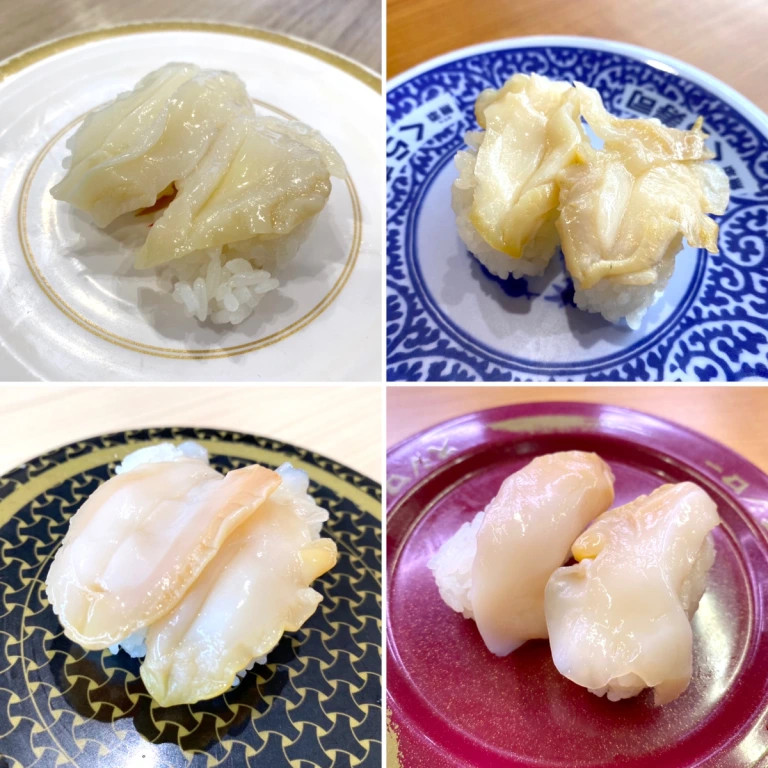
Our reporter didn’t have high hopes for this taste test…Did it surpass his expectations?
In the opinion of our Japanese-language reporter P.K. Sanjun, Japan’s four biggest conveyer belt sushi restaurants (Sushiro, Hamazushi, Kura Sushi, and Kappa Sushi) don’t have very good shellfish. To P.K., who likes shellfish so much he might have been a sea otter in a previous life, such seafood is supposed to be a luxury. But conveyor belt sushi restaurants sell things like blood clam, egg cockle, turban shell, abalone, and scallops for 300 yen (US$2.20) or less, and at that price, it’s hard for P.K. to find any that meet his personal standards.
But for the sake his quest to find the best of each kind of sushi between the big four conveyer belt chains, P.K. tried to overcome his distaste for budget-priced shellfish sushi, tasting and comparing several types between the restaurants. Ultimately though, his personal conclusion is that he’d rather pass on most of them entirely.
However, P.K. did find one reasonable and relatively edible shellfish sushi, and that was shiro tsubugai: white whelk, a type of sea snail, and so P.K. decided that it would be the representative for the “shellfish” category.
▼ Clockwise from top left: Kappa Sushi, Kura Sushi, Sushiro, and Hama Sushi
For the comparison, P.K. visited all four restaurants on the same day in a span of three hours. Performing the taste tests in such a short time ensured that he would best be able to compare the flavors of each one and accurately convey his experiences. Here’s what he thought:
● Kappa Sushi (110 yen [US$0.80])
“It’s characterized by its crisp texture, and it doesn’t really have a strong fishy smell. On the other hand, the meat is very thin, and I don’t get any of the sweetness or umami typical of shellfish. Well, considering the 110-yen price, I’d say that if texture is what’s important to you, this might be okay.”
● Kura Sushi (110 yen)
“Compared to Kappa Sushi’s, the meat is much thicker, and it has the crisp texture and umami I’m looking for. …But at the same time, its fishy smell really bothers me, so unless you’re the type of person who likes their shellfish to have a fishy smell, I really wouldn’t recommend it.”
● Hamazushi (110 yen)
“I like how it’s thick and crunchy. I also don’t really get a fishy smell from it. However, this one is pretty watery and has almost no umami or sweetness. Like Kappa Sushi’s, its emphasis is on texture.”
● Sushiro (165 yen)
“Out of the four restaurants this one is the most expensive at 165 yen. Maybe that’s because it’s a thick cut. I do get a sense of shellfish’s sweetness here. It has a really faint fishy smell, but I think it’s probably a tolerable level. Without considering the price, based purely on the sushi itself, I’d say out of the four restaurants this one is the best quality.”
Though Sushiro’s was by far the best quality, unsurprisingly for P.K., none of the conveyer belt sushi restaurants’ whelk sushi seriously impressed him. While all of the restaurants delivered on the crisp texture expected of the sea snails, he often found the flavor lacking, and even when it didn’t, the meat suffered from a fishy smell. As such, shiro tsubugai makes for a pretty hit-or-miss sushi, at least at conveyer belt sushi places, he feels.
In the end, P.K.’s general conclusion is that “There are better things than this to eat at conveyer belt sushi restaurants.” Shellfish fans with particular tastes may or may not like the four big chains’ whelk sushi, and those who don’t care for shellfish will probably order their myriad of other delicious sushi options, like prawn and saltwater eel, before they try this, so it comes down to your preferences.
Images © SoraNews24
● Want to hear about SoraNews24’s latest articles as soon as they’re published? Follow us on Facebook and Twitter!